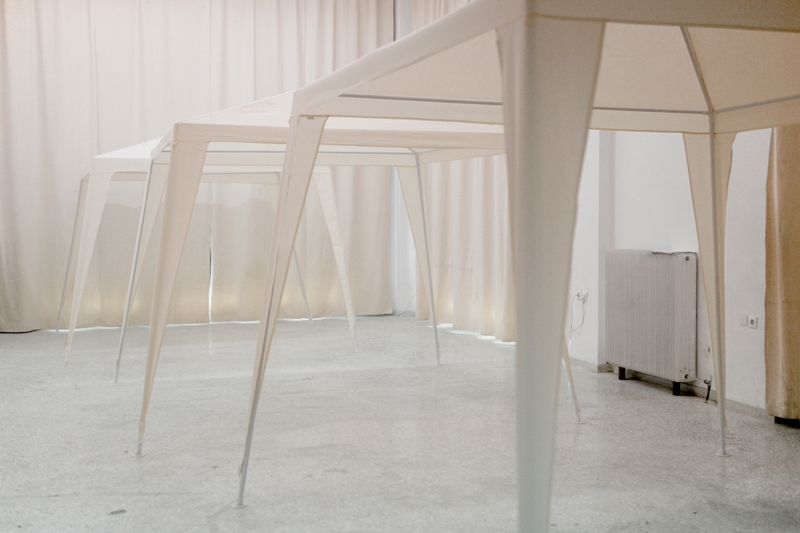A pair of pristine slippers, a trio of cheap gazebos and a quick reference to Eugène Ionesco’s 1950 play The Bald Soprano: you don’t need a lot more to frame up the aesthetic inclinations of the suburban middle-class. Guest-curated by the collective Radical Reading, Maria Georgoula’s Pom pom expedition is a take on the notion of softness: that of a blob, of an uncooked cake and of lethargic petty-bourgeois thought. Surrealism and absurdism are references for Georgoula’s work, although thinned down to a certain formalism that speaks and produces meanings mostly by ways of visual and tactile vocabularies – call it subtle anti-intellectualism, or just contemporary art. In other words, the ferocious class-related critique once fervently practised by Ionesco, Andr. Breton et al here seems to give way to a polite display of fluffy objects and plaster globs, distilling the banality of everyday life in a few gracious works, thoughtfully installed. What do the surreal and the absurd have to tell about the psyche of the middle class of the twenty-first century?
On the ground floor, the aforementioned white gazebos (Βατία / Vatía, 2015) take up most of the space, sitting one next to the other in the soothing creamy light that illuminates the room. On the wall, a couple of tableaux covered in amorphous plaster forms (Mr. and Mrs. Smith, 2014, the title of which directly references the Ionesco play) hang next to a tall bannerlike sculpture topped by an avocado (Φλάμπουρο / Banner, 2015), which refers to the wedding customs of some traditional Greek cultures. The basement space, featuring a built-in cage and two noisy fans embedded in the walls, feels in itself more underground. A long pole covered in furry fibreglass rests on the metal bars, soft and cuddly as the mascot of a fabric softener, protruding inside the gated space. In the cage, a box covered in plaster rests on the floor next to a pair of slippers, a symbolic presence indeed reminiscent of apathetic moments spent in front of hotel room televisions (Pad, 2015). On the other side of the room are two rumpled sculptures (Pom pom, 2015) made of those beaded covers that taxi drivers use for added comfort in their cars, but only on the driver’s seat, because they spend hours and hours sitting there and their customers do not.
Georgoula’s undecided forms, their morphological anarchism and their unengaged attention to the banal might well reflect a part of the collective and unconscious craving for comfort and apathy. There is an enigmatic approach to self-spectacularisation – a blessing and a curse – of the petty bourgeoisie, an approach that always stands between parody and detached participation. Is softness, the term itself, charged here with layers of latent meanings? For in relation to the present-day middle class it can suggest more than a couple of tempting associations: the property of giving little resistance to pressure; poor physical condition; a disposition to yield to the wishes of someone; the quality of being indistinct and without sharp outlines; acting in a manner that is gentle and mild and even-tempered. With regard to the representation of mental / emotional spaces here, a critical reading might embrace these clusters of attributes or dismiss class discourse altogether, as in that joke where one fish asks another, ‘So, how’s the water?’ and the other fish replies, ‘Water? What’s water?’
This article was first published in the May 2015 issue.
